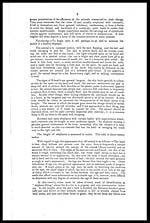Medicine - Veterinary > Veterinary diseases > Note on elephants in Burma, with a description of their equipment
(6) Page 4
Download files
Individual page:
Thumbnail gallery: Grid view | List view

4
them during the night. The thief who has been lying close by, waits till an
animal strays a bit, creeps up to him, cuts through the cane hobbles, and after
driving him a short distance, jumps on his back, and takes him the shortest cut
into Siam. The hills clad with very dense jungle afford such " gentlemen"
ample shelter; the owner, as a rule, has the good sense not to " hunt for a needle
in a bundle of straw."
Accomplished thieves make plenty of money, for they steal an animal in our
territory, sell him in Siam, steal him again a month or so after, bring him across
our frontier, and once more dispose of him to some one at a place many miles
distant from where they originally stole the beast. I once heard a man remark
that if he had anything to do with the framing of laws he would put " elephant-
lifting" under crimes punishable with death. Needless to add that he had lost
more than one animal in this unsatisfactory way ; by great good luck he recov-
ered one, after spending a few hundred rupees.
Distinctive marks are, as a rule, not very numerous on these creatures. Bur-
mese elephants may be divided into two classes, viz.,—
A. Timber elephants. These may again be put into two classes, viz.,—
(1) Trained tuskers.
(2) Trained males and females.
B. Baggage elephants.
A well-trained tusker always commands a high price in the market ; he is
much more useful than a tuskless animal, as with the aid of his tusks he can
stark timber, carry blocks on his tusks, turn logs over, and help in getting them
over obstacles. Prices run from Rs. 1,100 to Rs. 3,000, according to size, train-
ing, and the length and thickness of the ivory. Merchants are always ready
to buy, and are prepared to pay fancy prices. These animals are mostly em-
ployed in the yards. Dragging elephants : these are mostly tuskless males and
females, and are trained to the jungle-timber trade, which is very hard work ; they
have to drag the logs up hill and down dale, through thick cover, till they get
to a stream. Well-trained ones sell for a good figure—anything from Rs. 1,100
to Rs. 1,800. Most Burmese animals are trained to this work. Tuskers
are also employed in jungle work. The baggage animals are often Siamese
elephants. The demand is small, and they may be bought fairly cheap—Rs. 800
to Rs. 1,200—which, after all, is only what one has to pay for a respectable horse.
Tame animals are plentiful enough ; I know of one company that have at
least 600 elephants at their command. The firms engaged in this industry
own large numbers of elephants, but they also have a number of Burman, Karen,
and Shan contractors in their employ, who undertake to work out a certain
amount of timber at certain rates, employing their own animals : some of these
men own many animals.
Siam is the country in which to purchase these beasts, as they are cheap,
and are more accustomed to baggage work. Some of the firms buy many of
their animals over there. The usual way the merchants get at them is by send-
ing messengers to say that animals are required, and that they will be ready to
inspect any animals brought in to certain places on our frontier, on stated dates.
Dagwin, on the Salween, would be a good place to get at the Laos elephants,
as the grounds are distant only about three days' march. Papun, in the Salween
Hill Tracts, would also make a good base. I believe the average price is
Rs. 800. Muang-nan (Lat. 18º 50' N., Long. 100º 45' E ) is considered by Burmans
to be an excellent place to buy elephants. The price is said to be from Rs. 500 to
Rs. 1,000. Rahaing (Lat. 18º 50' N., Long, 99º 90' E.), on the left bank of the Me-
Ping, is also considered to be a good centre : a very extensive trade in teak is
carried on in the Rahaing district, and elephants are plentiful. The town itself is
distant about seventy miles from Myewaddi, one of our frontier posts in the
Maulmain district. Animals could be marched in with ease. Moung-Hpay is
another place in Siam. Some animals might also be bought at Kyauk-Kyoung,
which is not very far from our frontier in the Tavoy district.
Set display mode to: Large image | Zoom image | Transcription
Images and transcriptions on this page, including medium image downloads, may be used under the Creative Commons Attribution 4.0 International Licence unless otherwise stated. ![]()
| India Papers > Medicine - Veterinary > Veterinary diseases > Note on elephants in Burma, with a description of their equipment > (6) Page 4 |
|---|
| Permanent URL | https://digital.nls.uk/75189993 |
|---|




